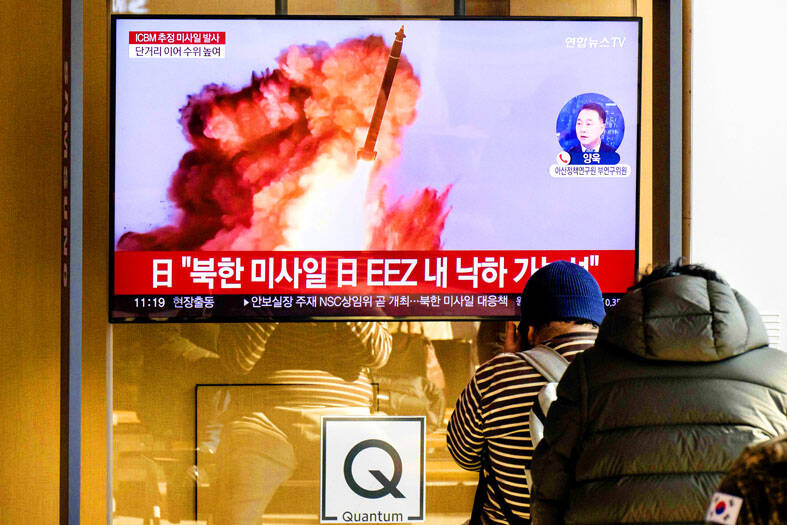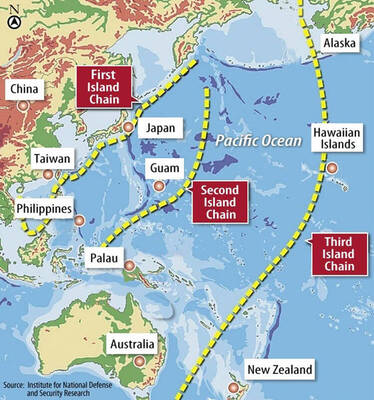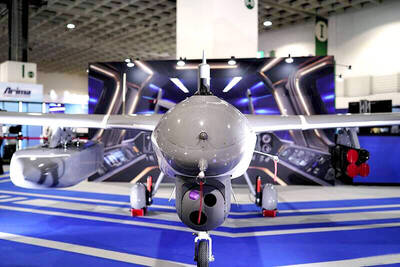North Korea yesterday fired an intercontinental ballistic missile that Japan said could have had the range to hit the US mainland.
The missile was believed to have landed in Japan’s exclusive economic zone, Japanese Prime Minister Fumio Kishida said as he criticized the launch as “absolutely unacceptable.”
The launch is Pyongyang’s second in two days and part of a record-breaking blitz in recent weeks.

Photo: AFP
Tokyo said that the missile could have had the range to hit the US mainland, based on its calculations.
The White House “strongly” condemned the test launch in a statement yesterday.
North Korea said the recent wave of launches is a response to Washington’s moves to bolster its protection of regional security allies South Korea and Japan.
The South Korean Joint Chiefs of Staff said it had “detected a long-range ballistic missile (ICBM) at about 10:15am, fired from the Sunan area in Pyongyang towards the East Sea,” referring to the body of water also known as the Sea of Japan.
The missile flew 1,000km at an altitude of 6,100km and a speed of Mach 22 (27,165kph), the South Korean military said, calling it a “serious provocation damaging peace and security on the Korean Peninsula.”
Japanese Minister of Defense Yasukazu Hamada said that the “ICBM-class missile” had been fired on a “lofted trajectory,” meaning the missile is fired at a steep angle, not outward, to avoid overflying neighboring countries.
“Based on calculations taking the trajectory into account, the ballistic missile this time around could have had a range capability of 15,000km, depending on the weight of its warhead, and if that’s the case, it means the US mainland was within its range,” he said.
The launch comes a day after North Korea fired a short-range ballistic missile, while North Korean Minister of Foreign Affairs Choe Son-hui said that Pyongyang would take “fiercer” military action if the US strengthened its “extended deterrence” commitment to regional allies.
Washington has been seeking to boost regional security cooperation and ramp up joint military drills in response to increasing provocations from the nuclear-armed North.
US President Joe Biden discussed North Korea’s recent missile tests with Chinese President Xi Jinping (習近平) earlier this week and also spoke with Japanese and Korean leaders, as fears grow that the reclusive regime could soon carry out its seventh nuclear test.
Experts said the launch of one of North Korea’s most powerful weapons was a clear sign that North Korean leader Kim Jong-un was displeased by the talks.
Firing an ICBM “is a clear message to the US and Japan,” said Han Kwon-hee, manager of the Missile Strategy Forum.
Another expert said that North Korea is seizing the timing as an opportunity to conduct banned missile tests, confident of escaping further UN sanctions due to Ukraine-linked gridlock at the UN.
“I primarily see these types of lofted ICBM tests as having a developmental purpose,” said Ankit Panda, Stanton senior fellow at the Carnegie Endowment for International Peace.
North Korea also launched an ICBM on Nov. 3, but experts said that weapon failed to fly as intended and fell into the ocean after a stage separation. That test was believed to have involved a developmental ICBM called Hwasong-17.
Its size suggests that it is designed to carry multiple nuclear warheads to defeat missile defense systems. Some experts say the Nov. 3 test showed some technological progress in its development, given that in its earlier test in March, the missile exploded soon after liftoff.
Pyongyang sees the US military presence in the region as proof of its hostility toward North Korea. It has said its recent series of weapons launches were its response to what it called provocative military drills between the US and South Korea.
Additional reporting by AP

The US government has signed defense cooperation agreements with Japan and the Philippines to boost the deterrence capabilities of countries in the first island chain, a report by the National Security Bureau (NSB) showed. The main countries on the first island chain include the two nations and Taiwan. The bureau is to present the report at a meeting of the legislature’s Foreign Affairs and National Defense Committee tomorrow. The US military has deployed Typhon missile systems to Japan’s Yamaguchi Prefecture and Zambales province in the Philippines during their joint military exercises. It has also installed NMESIS anti-ship systems in Japan’s Okinawa

‘WIN-WIN’: The Philippines, and central and eastern European countries are important potential drone cooperation partners, Minister of Foreign Affairs Lin Chia-lung said Minister of Foreign Affairs Lin Chia-lung (林佳龍) in an interview published yesterday confirmed that there are joint ventures between Taiwan and Poland in the drone industry. Lin made the remark in an exclusive interview with the Chinese-language Liberty Times (the Taipei Times’ sister paper). The government-backed Taiwan Excellence Drone International Business Opportunities Alliance and the Polish Chamber of Unmanned Systems on Wednesday last week signed a memorandum of understanding in Poland to develop a “non-China” supply chain for drones and work together on key technologies. Asked if Taiwan prioritized Poland among central and eastern European countries in drone collaboration, Lin

BACK TO WORK? Prosecutors said they are considering filing an appeal, while the Hsinchu City Government said it has applied for Ann Kao’s reinstatement as mayor The High Court yesterday found suspended Hsinchu mayor Ann Kao (高虹安) not guilty of embezzling assistant fees, reducing her sentence to six months in prison commutable to a fine from seven years and four months. The verdict acquitted Kao of the corruption charge, but found her guilty of causing a public official to commit document forgery. The High Prosecutors’ Office said it is reviewing the ruling and considering whether to file an appeal. The Taipei District Court in July last year sentenced Kao to seven years and four months in prison, along with a four-year deprivation of civil rights, for contravening the Anti-Corruption

NO CONFIDENCE MOTION? The premier said that being toppled by the legislature for defending the Constitution would be a democratic badge of honor for him Premier Cho Jung-tai (卓榮泰) yesterday announced that the Cabinet would not countersign the amendments to the local revenue-sharing law passed by the Legislative Yuan last month. Cho said the decision not to countersign the amendments to the Act Governing the Allocation of Government Revenues and Expenditures (財政收支劃分法) was made in accordance with the Constitution. “The decision aims to safeguard our Constitution,” he said. The Constitution stipulates the president shall, in accordance with law, promulgate laws and issue mandates with the countersignature of the head of the Executive Yuan, or with the countersignatures of both the head of the Executive Yuan and ministers or